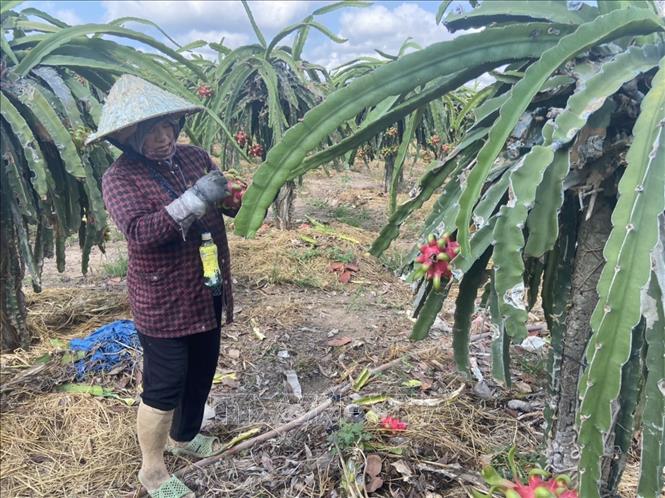
Farmers in Bưng Riềng commune, Xuyên Mộc district, stroking the lobes of dragon fruit to make them more appealing and thus fetch a higher price.
At this time, the off-season dragon fruit crop in Xuyên Mộc is nearing the end of its production cycle, and prices have been on a steady rise. However, due to prolonged hot weather, the yield of dragon fruit has been severely reduced. Therefore, despite the high prices, dragon fruit growers have not been able to fully capitalize.
Currently, white-flesh dragon fruit is being purchased by traders at around 15,000-18,000 VND/kg, while red-flesh dragon fruit is fetching 30,000-35,000 VND/kg (an increase of 10,000 – 13,000 VND/kg) compared to two weeks ago. These are high prices that would normally yield good profits for farmers. However, due to the current drought and water shortage, supply has been scarce, and farmers have had less produce to sell.
Mr. Trần Văn Thiệu’s family, in Hamlet 1, Bưng Riềng commune, Xuyên Mộc district, owns 1 hectare of red-flesh dragon fruit – 1,000 trees that are almost ready for harvest. Due to the off-season production – using lamps during the dry season – and the water shortage this year, the yield has been significantly reduced – only reaching 2 tons of fruit, which is 50% of previous harvests.
“When there is sufficient water, and the plants are properly fertilized and cared for, each tree can yield about 30 kg of fruit. However, due to the lack of irrigation water, the yield has been very low, only 10-15kg,” said Mr. Thiệu.
Similarly, Mr. Trần Văn Hiền’s 2-hectare red-flesh dragon fruit orchard, also in Hamlet 1, Bưng Riềng commune, has about another week before harvest. However, the yield is expected to be only 2 tons – instead of the 7 tons typically harvested during the off-season. Mr. Hiền had invested over 50 million VND in this crop. At the current selling price, after deducting expenses, he will only make a profit of over 20 million VND – a 1/3 reduction in earnings.
“If there was no water shortage, the dragon fruit plants would have maintained a healthy canopy, but now, due to the lack of water, the yield has dropped,” said Mr. Hiền.
The province currently has around 712 hectares of dragon fruit, mainly concentrated in Xuyên Mộc district. Many dragon fruit farms in Bông Trang commune, Xuyên Mộc district, are also facing reduced yields due to the prolonged hot weather and reduced water sources. To keep their dragon fruit trees alive, many farmers have had to spend money on pumping water from the Sông Hỏa reservoir for irrigation, but even this water source is limited.
According to dragon fruit farmers, one of the reasons for the supply shortage is the severe drought and water shortage that has been affecting the province since the beginning of the year, which has made it difficult for farmers to care for the off-season crop; the rate of flowering and fruit setting has been only 50-60%. Therefore, a reduction in dragon fruit yield was inevitable
Mr. Nguyễn Quốc Đại, Deputy Head of the Xuyên Mộc District Department of Agriculture and Rural Development, said that in the face of the drought, the district’s agricultural sector has advised people not to engage in off-season production during the current dry, hot weather, especially in areas with water scarcity. Production under conditions of water shortage will greatly affect crop yields, as well as the long-term health of the plants, which may become weakened and die.
For short-term crops, farmers should plant according to the proper seasonal schedule and in accordance with the water availability of each region; use varieties that are adapted to drought and saline conditions; and apply scientific and technical advances in crop cultivation and care under water scarcity conditions, such as automatic irrigation, drip irrigation, misting, etc., to save water efficiently.
To date, the District Department of Agriculture has advised local residents about the drought and salinity tolerance of various common crops so that they are aware of their water requirements; and has taken a firm stance against allowing people to farm in areas at risk of water shortage.
The Deputy Head of the Xuyên Mộc District Department of Agriculture and Rural Development also advised farmers to use water sparingly, avoid waste, and plan their irrigation accordingly. In particular, farmers should also pay attention to the local government’s recommendations before each planting season in order to plan their production activities appropriately and avoid negative impacts on crop yields.





![[Photo Essay]: Experts, Managers, and Businesses Unite to Forge a Path Towards Sustainable Green Industry](https://xe.today/wp-content/uploads/2025/07/z678592918-218x150.jpg)






























